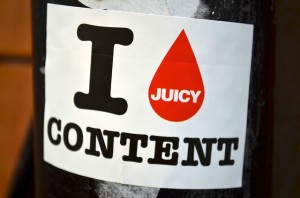 In the March 21 Forrester report on “How To Build Your Brand With Branded Content,” principal analyst Tracy Stokes, who created the report along with David M. Cooperstein and Alexandra Hayes, noted that in today’s connected world, “traditional marketing vehicles” are increasingly ineffective in capturing consumers’ attention and keeping them engaged. Marketers, according to the report, should use “branded content to build the trusted, remarkable, unmistakable, and essential brand that will drive success.” [Emphasis ours throughout.]
In the March 21 Forrester report on “How To Build Your Brand With Branded Content,” principal analyst Tracy Stokes, who created the report along with David M. Cooperstein and Alexandra Hayes, noted that in today’s connected world, “traditional marketing vehicles” are increasingly ineffective in capturing consumers’ attention and keeping them engaged. Marketers, according to the report, should use “branded content to build the trusted, remarkable, unmistakable, and essential brand that will drive success.” [Emphasis ours throughout.]
The report states:
Chief marketing officers (CMOs) must adapt their marketing strategies to build brand advantage in the face of consumers’ rapidly changing media consumption landscape. Branded content is a powerful tool to help build a brand, but marketers run a gauntlet of obstacles to harness it effectively.
The report also introduced “Forrester’s four C’s framework for effective use of content for brand building”:
- capture the brand’s North Star in branded content;
- connect to your consumers in context;
- create visible value through the content; and
- continuously measure and optimize results.
Speaking of brand-building, Adweek reported last week that Contently is apparently rolling out a number of new features “for brands that are pushing to communicate with consumers with stories and blogs that don’t look or sound like advertising.” Lucia Moses reminds us that the startup initially focused on freelancers, but eventually its clients have expanded to publishers (The Atlantic, Forbes) and big brands like Procter & Gamble. To successfully use content marketing and native advertising, writes Moses, brands need to “be able to demonstrate through metrics that the outcome is something people actually want to engage with.”
Contently is intent on helping brands do just that. Moses lays out the impending changes in the company’s offerings and partnerships:
Contently is expanding its contributor roster to include photographers, infographic artists and editors, starting with a partnership with designer marketplace Visual.ly. Clients will be able to build custom groups of contributors, communicate with them and get story ideas from them as a group.
Other changes are designed to smooth out the legal signoff and internal content approval process that organizations deal with when contracting to use outside talent. A new suite of analytics will measure the reach (impressions), engagement (minutes spent) and influence (action taken via shares, comments and subscribes) of each story a brand publishes.
Sounds good, yet some questions arise, such as: How do you use branded content to educate and inform, and avoid pushing the product too hard? “Have a plan, execute the plan and then measure the results over and over,” says Steve Olenski at Forbes. “And by all means, tell a story. But just not any story.”
Branded content marketing, Olenski says, commenting on the Forrester report mentioned above, “is not the place to go on and on about how great your brand is and how great your new widget is or anything even remotely tied to sales.”
And then there’s a question of ethics, especially when it comes to brands creating editorial content for promotional purposes. Mashable printed a long article on March 18, penned by Sam Slaughter, the VP of Content at Contently, who, of course, speaks in favor of native advertising and discusses its potential for publishers.
Slaughter writes:
The buzz is whether brand-sponsored content is ruining publishing. But what if publishers could take control of the trend?
Call it what you want — content marketing, native advertising, brand publishing — but the idea that advertisers can create editorial content has gained an amazing amount of momentum over the past two years. […]
Even brands that don’t have dedicated editorial teams have begun tapping journalists to create ‘native ads,’ in many ways indistinguishable from the journalistic content along which they appear. […]
The debate over the ethicality of these ads is by no means settled. But what’s clear is that the line between content and ads is becoming ever more blurry, a reality that both publishers and advertisers will have to [address] if they’re going to prosper.
Slaughter lists The Onion and Gawker as “but two examples on a laundry list of new media companies that have realized the earning potential of the agency model.” He also mentions BuzzFeed‘s in-house editorial team that works on content creation for advertisers, and the Atlantic Media Strategies dedicated to coming up with “agency solutions for brands.”
Slaughter doesn’t think that those in-house mini-agencies, with their editorial expertise and dedication to brands, pose any threat to the outside ad agencies. He points out that this trend is in its beginner stage anyway, and there are no hard numbers yet showing how much revenue they generate for their parent companies.
The bigger question is, can they exist within their publisher hosts without tarnishing those entities’ editorial cred — even with the clear transparency rules strictly enforced? And, simply put, could they help their parent companies stay in business? “We’re a long way from knowing,” writes Slaughter, “but for an industry that’s fighting for survival, the more ammunition the better.”
Image by Garry Knight.